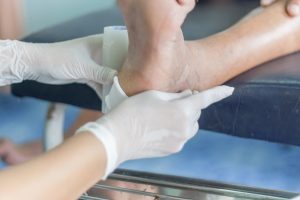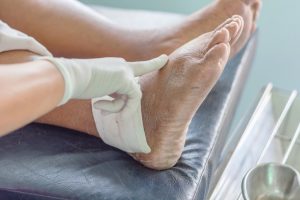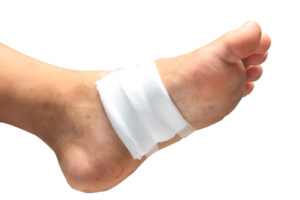A foot ulcer is a break in the skin or a deep sore, which can become infected.
Some of the most common causes of foot ulcers include:
- Circulatory problems – Your circulatory system carries oxygen-rich blood and nutrients to your entire body. These nutrients maintain healthy tissue. When someone experiences circulatory issues, the feet are typically one of the first places where problems can occur.
- Nerve damage – When nerves are intact, they send signals to the brain when an object is causing pain. If someone has damaged nerves, they do not receive these signals and they are unable to identify when something is causing harm to the tissue. Failure to address the issue can result in irritation and potentially an ulcer.
- Prolonged pressure on the feet – Ulcers can occur even in people without nerve damage when they wear shoes that fit poorly This is usually due to severe atherosclerosis, or a deformity such as a fracture. In addition, Elderly patients may have difficulty examining their feet, ignoring pain from pressure on the feet, which may lead to an ulcer.
- Various health conditions – Ulcers are an indication that a severe stage of a condition such as peripheral artery disease, kidney failure, diabetes, hypertension, or high cholesterol is present. A physician can offer strategies such as medication management, healthy diet, exercise, and proper weight management to help manage these conditions.
- Lifestyle issues – Smoking is a leading contributor to ulcers as it increases the risk of developing a variety of conditions that can lead to the development of them. In addition, leading a sedentary lifestyle can increase your chances of developing foot ulcers. Avoiding prolonged periods of bed rest or non-mobility can decrease the likelihood of developing ulcers.
If left untreated for too long, a foot ulcer can cause serious consequences including potential amputation.
The three most important ways to avoid this is from happening is educating yourself about foot ulcers, wearing the appropriate shoes, and maintaining your regularly-scheduled appointments with your doctor
Flushing Hospital’s Wound Care Center wants to help our community put a stop to foot ulcers through proper care and early detection, which can greatly reduce the risk of amputation and improve overall quality of life.
If you have a foot ulcer and need help treating it, please call Flushing Hospital’s Wound Care at 718-670-4542 to schedule an appointment.
All content of this newsletter is intended for general information purposes only and is not intended or implied to be a substitute for professional medical advice, diagnosis or treatment. Please consult a medical professional before adopting any of the suggestions on this page. You must never disregard professional medical advice or delay seeking medical treatment based upon any content of this newsletter. PROMPTLY CONSULT YOUR PHYSICIAN OR CALL 911 IF YOU BELIEVE YOU HAVE A MEDICAL EMERGENCY.



